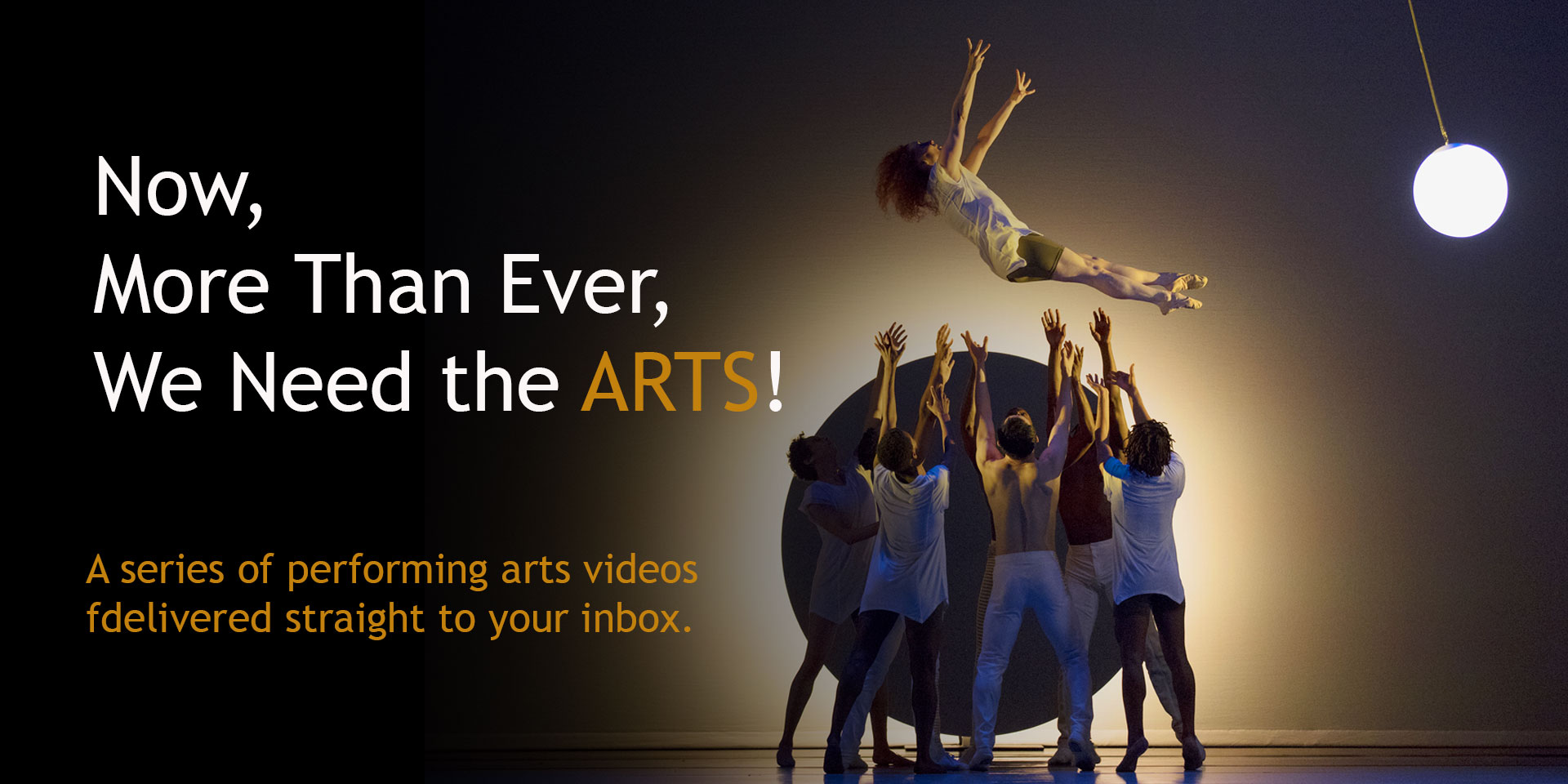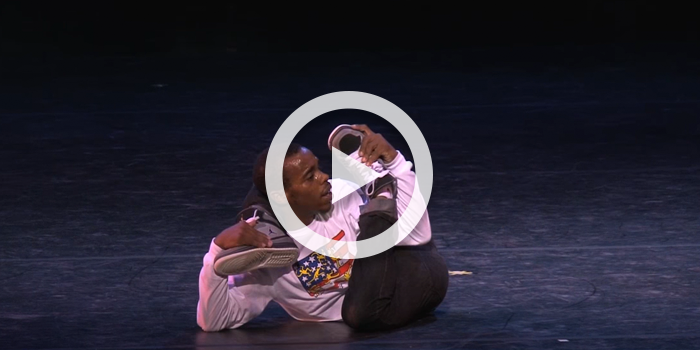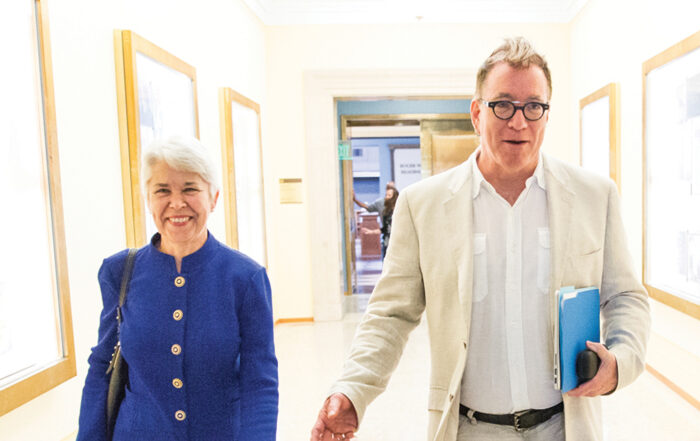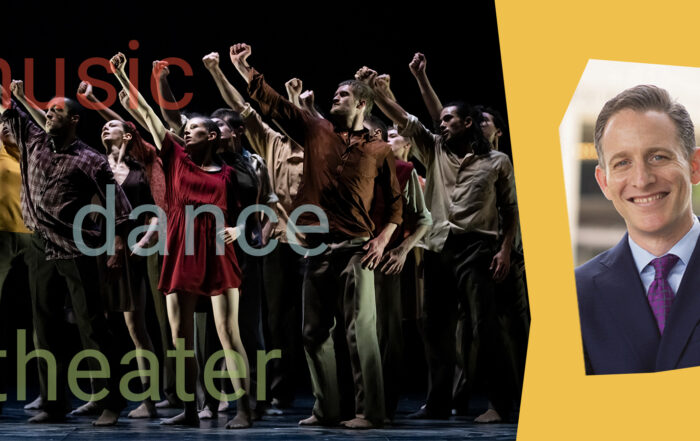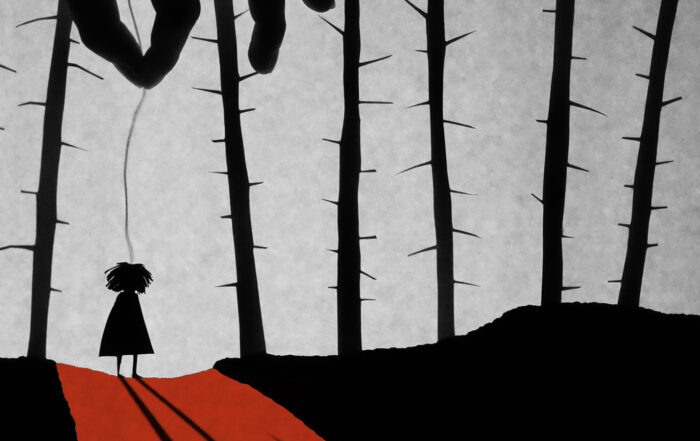In this issue: acrobat/dancer Yoann Bourgeois performs to Debussy’s “Clair de lune;” Janine Jansen performs Saint-Saëns’ Introduction and Rondo Capriccioso with the Berlin Philharmonic; vocalist La Caíta performs “El pájaro negro” from Latcho Drom; Sheku Kanneh-Mason and Friends perform Leonard Cohen’s “Hallelujah;” Nederlands Dans Theater performs Paul Lightfoot’s Standby
Now, More Than Ever: Issue 28
Debussy: “Clair de lune” from Suite bergamasque
Yoann Bourgeois, acrobat/dancer
Alexandre Tharaud, piano
Sometimes referred to as the “Tate Modern of the Internet,” the website Colossal is an international platform for contemporary art and visual expression that explores a wide range of disciplines. In October 2017, the website wrote:
Visitors to the Panthéon in Paris earlier this month have been encountering an unusual sight. For about 10 days in October, multidisciplinary movement artist Yoann Bourgeois installed a rotating circular stairway with a discrete trampoline at its center, and a small cast of anonymously clothed dancers trudged up the steps, each one falling in succession onto the trampoline and seamlessly rebounding back onto the stairs.
I was happy to see Colossal’s account of Bourgeois’ performance piece, because after first watching this Now, More Than Ever selection—a jaw-dropping collaboration between the inventive acrobat/dancer (some even call him a “slapstick comedian”) and the exquisite French pianist Alexandre Tharaud—I found myself honestly wondering if the whole business didn’t simply rely on trick photography.
Of course, if this were a “trick,” it would be wonderful enough, but miraculously, no such sleight of hand is at play; all of this movement is breathtakingly “real.” What truly lifts the performance into the realm of art, however, is the inspired marriage of Bourgeois’ physical work with Debussy’s timeless “Clair de lune,” surely one of the most perfect and transporting piano pieces ever written.
Here, Tharaud brings both sensitivity and understatement to his playing, something that will come as no surprise to anyone familiar with his brilliant 2011 Domenico Scarlatti disc. (If there’s anyone out there who still subscribes to the idea that “major equals happy” and “minor equals sad,” just listen to the pianist’s take on the composer’s Sonata in A major, K. 208, one of classical music’s most heartfelt and heartbreaking compositions.) I love Tharaud’s approach to playing Scarlatti on a modern piano; he always keeps in mind the sonorities of the harpsichord for which the composer wrote.
Saint-Saëns: Introduction and Rondo Capriccioso
Janine Jansen, violin
Neeme Järvi, conductor
Berlin Philharmonic
When I was a music student, I never would have believed I would one day include this piece on a list of my favorite performances. You hear this chestnut constantly in conservatories, usually performed by fiddlers striving for (though perhaps not always achieving) nothing more than a wink and smile. But in the hands of Janine Jansen, surely one of the most poetic and technically accomplished violinists of the day, it turns into pure poetry.
The last four pages of the solo part are an infamous high-wire act—if you miss a single note, it’s very hard to get back on track—but such is Jansen’s assurance that you never doubt that she’ll make it to the finish line. What distinguishes her playing—and this particular performance—is that rare spark of utter spontaneity; the music feels truly alive, as if she’s creating it right there, on the spot.
A side note: TwoSet Violin was founded in 2014 by Australian duo Brett Yang and Eddy Chen, going viral with its funny and sometimes painfully accurate video depictions of life as a classical musician. With more than 4.5 million followers on social media (and 500+ million views!), TwoSet inspires musicians worldwide with humor and a relatable “imperfectness.” On several occasions the two men have proclaimed Jansen one of their idols. In this short video clip, Eddy meets Janine for the first time.
“El pájaro negro” from Latcho Drom
La Caíta, vocals
The winding paths of YouTube led me recently from a documentary on Domenico Scarlatti, which explored the influence on his music of flamenco and “Gypsy” music (“Gypsy” is a term perhaps best avoided, as for so many it is considered pejorative), to Latcho Drom, an acclaimed 1994 film by Tony Gatlif. Writing in the New York Times, Stephen Holden described the movie as “an intensely lyrical portrait… a musical travelogue that uses traditional songs instead of spoken words to evoke the unhappy history of the Rom people. From its opening desert scenes, the movie follows the westward migratory path the Roms took from India a thousand years ago. By the beginning of the 16th century, they had settled throughout Europe.”
There’s a long tradition of the Rom people in Spain (Bizet’s Carmen, after all, was Rom); indeed, much of the music we think of today as Spanish would be unrecognizable without Rom influence. In this, the final scene of Latcho Drom, the mesmerizing vocalist/actress La Caíta mourns centuries of persecution as her plaintive question (“Why does your mouth spit on me?”) echoes out over the distant—in more ways than one—Spanish metropolis that expands on the plain below her.
It strikes me that the only really truly instrument in flamenco music is the guitar (which often isn’t even used). In this art form, the clapping of hands (sometimes simply, sometimes in incredibly complex rhythms) can create an absolutely propulsive drive, providing the fuel for profound expressions of pride, despair, and hope.
Leonard Cohen (arr. Tom Hodge): “Hallelujah”
Sheku Kanneh-Mason and Friends
Given the number of requests that Leonard Cohen’s “Hallelujah” be performed at wedding ceremonies, one has to wonder how many people actually listen to the lyrics, which are pretty dark. But the melody is one of the most beloved of our time and this arrangement for the dazzling British cellist Sheku Kanneh-Mason is just lovely. (Sheku and his pianist sister Isata, two of the seven musical Kanneh-Mason children, made their Cal Performances debut last December at a thrilling recital in Zellerbach Hall.) Included here are Didier Osindero on violin, Alinka Rowe on viola, and Yong Jun Lee on cello.
Standby
Paul Lightfoot, choreographer
Nederlands Dans Theater
Cal Performances regrets that this YouTube video has been removed by the owner.
Company artistic director Paul Lightfoot and Nederlands Dans Theater have just released a choreographic response to the coronavirus pandemic and the results are both clever and moving. (Lightfoot ends his NDT tenure next week, after leading the esteemed company for nearly a decade.) Employing the same gestures—sometimes delivered with a touch of humor—and the same techniques that company members repeat every day as part of class, Standby offers both comfort and consolation to anyone living in a time of physical distancing and social isolation.
Lightfoot writes:
I have created a 40-minute work based on Knudåge Riisager’s music called Etudes, which takes the audience through a cascade of exercises from our daily classical ballet technique. I have choreographed, along with the artists, an NDT take on Harold Landers classical ballet of how we incorporate the tools of our trade using all 42 members of the company.
The inspirational challenge was to do this using the protocols and limitations of social distancing. We marked the floor into squares of three meters to lay a base for the structure. The only people who were able to physically touch each other were the dancers who lived together in the same household.
Can we connect without touch? I felt we could!
Standby would be impressive at any time, but coming as it does in the summer of 2020, it’s both overwhelming and unforgettable, truly an example of using constraints to achieve powerful outcomes. And it features some of the most beautiful use of stage lighting I’ve ever seen.
Now, More Than Ever Full Playlist
Now, More Than Ever Spotify Playlist


